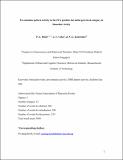Pre-stimulus pattern of activity in the fusiform face area predicts face percepts during binocular rivalry
Author(s)
Hsieh, Po-Jang; Colas, Jason T.; Kanwisher, Nancy
DownloadHCK.BRfMRI.neuropsy.2012[1].pdf (636.9Kb)
PUBLISHER_CC
Publisher with Creative Commons License
Creative Commons Attribution
Terms of use
Metadata
Show full item recordAbstract
Visual input is ambiguous, yet conscious experience is unambiguous. In binocular rivalry the two eyes receive conflicting images, but only one of them is consciously perceived at a time. Here we search for the neural sites of the competitive interactions underlying this phenomenon by testing whether neural pattern activity occurring before stimulus presentation can predict the initial dominant percept in binocular rivalry and, if so, where in the brain such predictive activity is found. Subjects were scanned while viewing an image of a face in one eye and an image of a house in the other eye with anaglyph glasses. The rivalrous stimulus was presented briefly for each trial, and the subject indicated which of the two images he or she preferentially perceived. Our results show that BOLD fMRI multivariate pattern activity in the fusiform face area (FFA) before the stimulus is presented predicts which of the two images will be dominant, suggesting that higher extrastriate areas, such as the FFA, are not only correlated with, but may also be involved in determining the initial dominant percept in binocular rivalry. Furthermore, by examining pattern activity before and after trial onset, we found that pre-trial activity in the FFA for the rivalrous face trials is no more similar to the post-trial activity for the non-rivalrous face trials than to that for the non-rivalrous house trials, indicating a dissociation between neural pattern information, which predicts a given state of awareness, and mean responses, which reflect the state of awareness ultimately achieved.
Date issued
2011-09Department
Massachusetts Institute of Technology. Department of Brain and Cognitive Sciences; McGovern Institute for Brain Research at MITJournal
Neuropsychologia
Publisher
Elsevier
Citation
Hsieh, P.-J., J.T. Colas, and N.G. Kanwisher. “Pre-Stimulus Pattern of Activity in the Fusiform Face Area Predicts Face Percepts During Binocular Rivalry.” Neuropsychologia 50, no. 4 (March 2012): 522–529.
Version: Author's final manuscript
ISSN
00283932